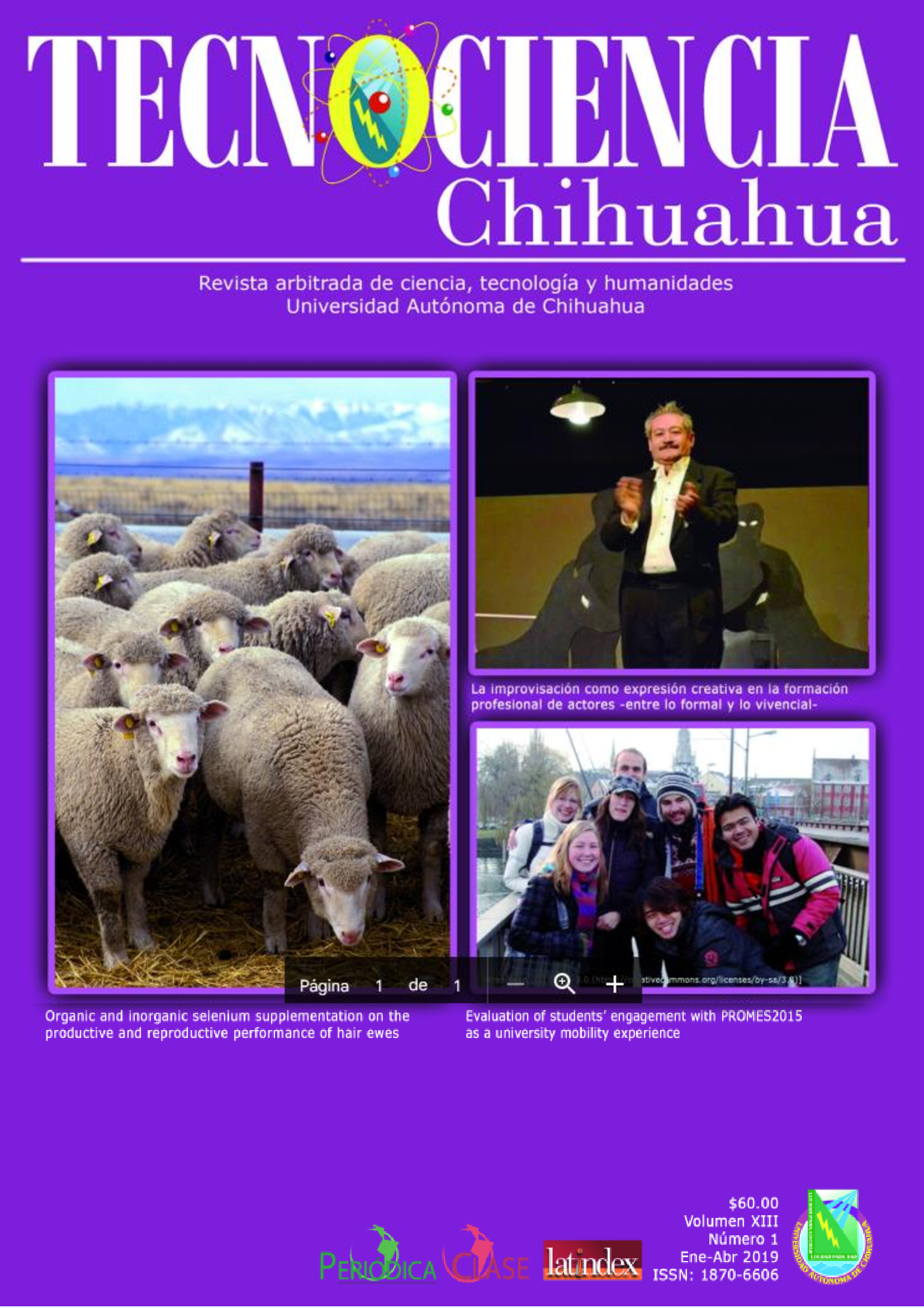Organic and inorganic selenium supplementation on the productive and reproductive performance of hair ewes
Suplementación con selenio orgánico e inorgánico sobre el comportamiento productivo y reproductivo de ovejas de pelo
Resumen
The objective of this study was to evaluate the effect of supplementation with organic and inorganic selenium on the productive and reproductive performance of ewes and their offspring. Selenium (Se) is an essential mineral for sheep, studies have found its intestinal absorption and biodisponibility in the animal is greater when it comes from an organic source. A total of 18 multiparous and 22 nulliparous ewes Pelibuey breed were used in this study, averaging 54.8 ± 9.4 kg and 39.7 ± 5.6 kg of body weight (BW). The experimental units were blocked by the number of parturitions (none or more than one). Then randomly assigned to one treatment: basal diet +1.2 ppm of organic Se (OSe, Sel- Plex®) or basal diet +1.2 ppm inorganic Se (ISe). Using the linear model PROC MIXED, BW changes were measured in ewes and average daily gain (ADG) in offspring. Fisher’s test, chi-squared test and t test were used for analyzing reproductive rates and production efficiency. No differences (P > 0.05) were found for BW changes, productive efficiency, and pregnancy rate between treatments. Prolificacy was higher (P < 0.05) for primiparous ewes in the OSe group vs the ISe group (66.7 vs 18.2 %). No differences (P > 0.05) were found for birth weights of lambs. The ADG was higher (P < 0.05) for the offspring of ISe vs OSe ewes. This indicates that the OSe supplementation improves reproductive parameters, but not the productive such as ADG.
Citas
Aréchiga, C. F., O. Ortiz & P.J. Hansen, (1994). Effect of prepartum injection of vitamin E and selenium on postpartum reproductive function of dairy cattle. Theriogenology 41(6):1252-1258. ISSN 0093-691X. https://doi.org/10.1016/0093-691X(94)90482-X
Awadeh, F. T., R. L. Kincaid, & K. A. Johnson. (1998). Effect of level and source of dietary selenium on concentrations of thyroid hormones and immunoglobulins in beef cows and calves. Journal of Animal Science. 76(4):1204-1215. https://doi.org/10.2527/1998.7641204x
Combs, G. F. & S. B. Combs. (1984). The nutritional biochemistry of selenium. Annual Review Nutrition. 4:257-280. https://doi.org/10.1146/annurev.nu.04.070184.001353
Davis, P. A., L. R. McDowell, N. S. Wilkinson, C.D. Buergelt, R. Van Alstyne, R. N. Weldon, & T. T. Marshall. (2006). Effects of selenium levels in ewe diets on selenium in milk and the plasma and tissue selenium concentrations of lambs. Small Ruminant Research 65(1-2):14-23. ISSN 0921-4488. https://doi.org/10.1016/j.smallrumres.2005.06.016
Hall, J. A., R. J. Van Saun, G. Bobe, W. C. Stewart, W. R. Vorachek, W. D. Mosher, T. Nichols, N. E. Forsberg, & G. J. Pirelli, (2012). Organic and inorganic selenium: I. Oral bioavailability in ewes. Journal of Animal Science 90(2):968-576. https://doi.org/10.2527/jas.2011-4075
Hidiroglou, M., J.Proulx, & J. Jolette. (1987). Effect of intraruminally administered, selenium soluble-glass boluses on selenium status in cows and their calves. Journal of Animal Science. 65(3): 815-820. https://doi.org/10.2527/jas1987.653815x
Koyuncu, M. & H. Yerlikaya. (2007). Effect of selenium-vitamin E injections of ewes on reproduction and growth of their lambs. South African Journal of Animal Science 37(4):233-236. https://bit.ly/3dKIIXA
National Research Council (NRC). (2007). Nutrient requirements of small ruminants: sheep, goats, cervids, and new world camelids. Washington, D.C., USA. National Academy Press. https://nap.nationalacademies.org/read/11654/chapter/1
Sánchez, J., A. Jiménez, S. Regodón & S. Andrés. (2008). Inhibitory effect of selenium supplementation on the reproductive performance in synchronized Merino sheep at range conditions in a selenium-deficient area. Reproduction of Domestic Animals 43(3): 328-332. https://doi.org/10.1111/j.1439-0531.2007.00904.x
Segerson, E. C., F. C. Gunsett & W. R. Getz. (1986). Selenium-vitamin E supplementation and production efficiency in ewes marginally deficient in selenium. Livestock Production Science 14(2): 149-159. https://doi.org/10.1016/0301-6226(86)90004-7
Steen, A., T. Strøm & A. Bernhoft. (2008). Organic selenium supplementation increased selenium concentrations in ewe and newborn lamb blood and in slaughter lamb meat compared to inorganic selenium supplementation. Acta Veterinaria Scandinavia 50(1): 7. https://doi.org/10.1186%2F1751-0147-50-7
Stewart, W. C., G. Bobe, W. R. Vorachek, G. J. Pirelli, W.D. Mosher, T. Nichols, R. J. Van Saun, N. E. Forsberg & J. A. Hal. (2012). Organic and inorganic selenium: II. Transfer efficiency from ewes to lambs. Journal of Animal Science 90(2): 577–584. https://doi.org/10.2527/jas.2011-4076
Surai, P. F. (2001). Selenio orgánico: beneficio para los animales y humanos desde el punto de vista de un bioquímico. En M. L. Gutiérrez & L. G. Hoyos (Eds.), Biotecnología en la industria de la alimentación animal, Vol. VIII, Altech (pp. 109-167). México DF.
Wichtel, J. J., A. L. Craigie, D. A. Freeman, H. Varela-Alvarez & N. B. Williamson, (1996). Effect of selenium and iodine supplementation on growth rate and on thyroid and somatotropic function in dairy calves at pasture. Journal of Dairy Science 79(10):1865-1872. ISSN 0022-0302. https://doi.org/10.3168/jds.S0022-0302(96)76554-2
Derechos de autor 2019 TECNOCIENCIA Chihuahua

Esta obra está bajo licencia internacional Creative Commons Reconocimiento-NoComercial 4.0.







